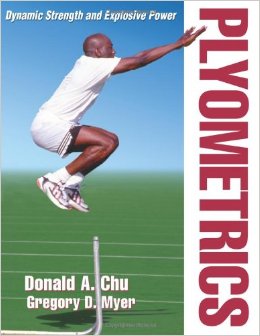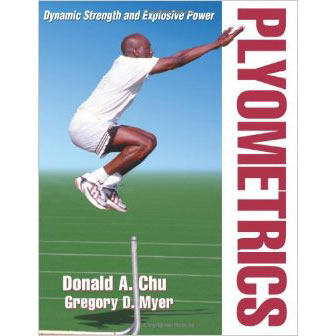
Review By Patrice Harris
Plyometrics: Dynamic Strength and Explosive Power by Donald A. Chu and Gregory D. Myer discusses how to increase an athlete’s overall performance by using plyometric exercises and the physical concepts upon which they are based. They also discuss how specially designed training programs can help the multidirectional athlete increase their abilities in each specific sport in which they participate.
What are Plyometrics?
Don Chu defines plyometrics as “exercises that enable the muscle to reach maximum strength in as short a time as possible.” The term coined in the book to describe this process is called the stretch-shortening cycle (SSC) and it is the major concept upon which plyometrics is based. The plyometric exercises are designed to create power needed for optimal athletic performance.
Why use Plyometrics?
Plyometrics is based on producing power. In order for an athlete to be successful in their chosen sport, they need to be able to produce power efficiently and effectively. Training using plyometrics conditions the athlete and their muscles to utilize the strength of their muscles to create needed power.
About the book
Plyometrics is geared toward coaches of teenagers as well as adults however, the concepts in the book are easily understood by the athlete that is involved in self training. Plyometrics is very detailed in its discussion of the subject of muscle movement and plyometric training. The book is broken down into three parts:
Part 1
Part 1 discusses the concepts upon which plyometrics is based—muscle action. The anatomy of the muscle and how it reacts to stimulation during plyometric training is detailed verbally and visually with plenty of images to show movement of the athlete during training exercises. Different training goals are used to illustrate how plyometrics is used to achieve various aspects of athletic performance.
Part 2
Certain aspects of the athlete must be evaluated prior to beginning a plyometrics training routine. Part 2 defines plyometrics and the physiology of the exercises used in plyometric training. The phases of plyometric exercises are explained in detail with images to show the body movement of the athlete during training. The anatomy of the muscle is also explained. The Kindle version also includes video of some of the exercises to further enhance understanding of the concepts. These videos are a very useful resource. They animate the provided images. This part of the book will teach the coach and athlete about the structure of the muscle and how they work during sports activity. It also gives complete information regarding using plyometric training during rehabilitation after a sports injury.
Part 3
Finally, Part 3 is where it all comes together. The prior explanations of plyometric techniques and their uses and the technical information on the anatomy of muscles and how they are effected and become more effective during sports using plyometric training is illustrated in the applications of plyometric training. This part is full of series of plyometric exercises and training routines that are sport-specific and comprehensive. Again, the digital version of the book contains helpful videos including some with Dr. Don Chu explaining concepts and giving information about effectively using plyometric exercises. This section if filled with diagrams, sample programs and images that make it easy to formulate an individual program of any athlete.
Concluding Remarks
As an athlete, I found the book to be easy to understand. The information about types of muscle actions—eccentric, isometric, and concentric and the information about injury rehabilitation using plyometric training were of interest to me. I bike ride and play tennis on a regular basis along with a consistent workout schedule throughout the week. I have been injured during sports play. One of my goals is to become competitive in both tennis and biking. The knowledge of plyometric training will help me to enhance my performance. I have also learned from the book, the importance of tailoring a program based on my athletic ability and endurance. This book very educational and I would recommend it to all involved in sports and training.
About the Authors
Dr. Donald A. Chu graduated from Stanford University in 1974 with his Ph.D. He also earned a degree in Physical Therapy from Stanford. From California State University, Hayward, he earned his Masters in Kinesiology and Physical Education. Dr. Chu has 20 years teaching experience and currently serves as Clinic Director of Athercare Fitness and Rehabilitation. His certifications include: Athletic Trainer (ATC) and Certified Strength and Conditioning Specialist (CSCS). Dr. Chu serves as the President of the California State Board of Physical Therapy. Dr. Chu has written several books about plyometric exercises and training, has contributed chapters to other books about sports medicine and has created training and conditioning programs for elite athletes at every level.
Dr. Gregory D. Myer graduated from Rocky Mountain University in Provo, Utah in 2010 with his Ph.D. Dr. Myer’s has been involved with creating ways to prevent knee injuries and has received numerous honors for the excellence of his work. He currently serves as the Director of Research at Cincinnati Children’s Hospital Medical Center at their Human Performance Laboratory in the Division of Sports Medicine. Dr. Myer writes about the biomechanics of knee injuries and knee injury prevention training and has published numerous articles, books and chapters included in books on the subjects.
Dr. Chu and Dr. Myer are certainly qualified to bring credible information to the sports training community. All people involved in the athletic community will find something that they can use to improve their performance. Readers will also learn more about the physiology of muscles and how plyometric exercises effect them.
Please share this article so others may benefit.
[mashshare]References
Gregory D. Myer, PhD, FACSM, CSCS*D. N.p., n.d. Web. 01 May 2014.
Donald A. Chu, Ph.D. N.p., n.d. Web. 01 May 2014.
Chu, Donald A., and Gregory D. Myer. Plyometrics: Dynamic Strength and Explosive Power. U.S.A,: Human Kinetics, 2013. Print.



